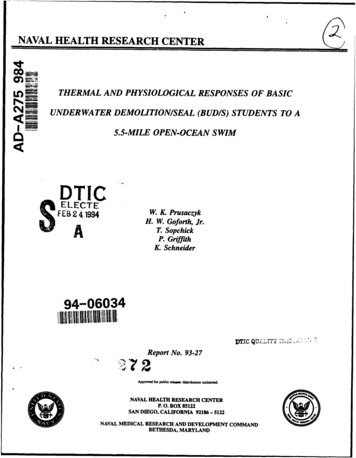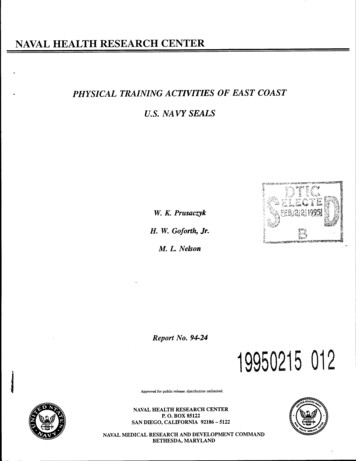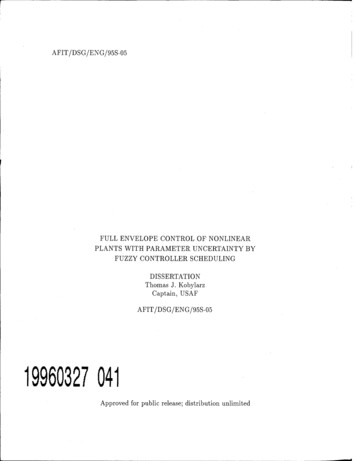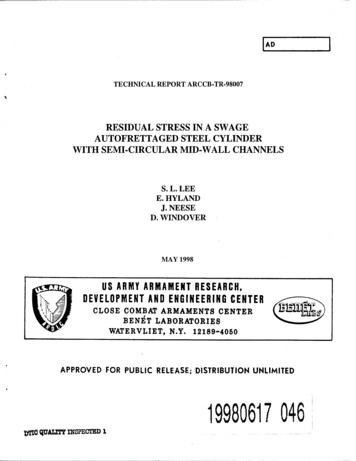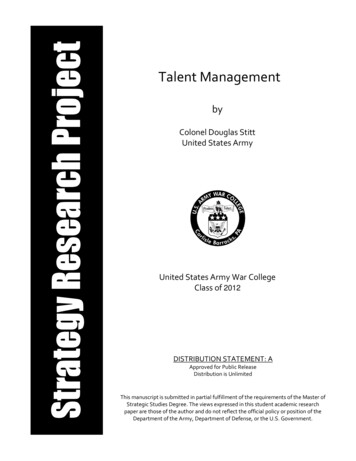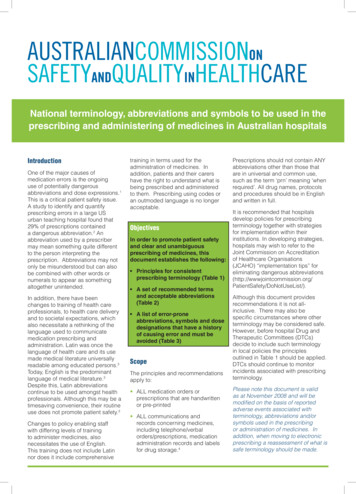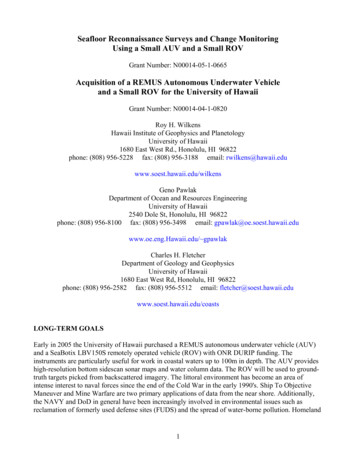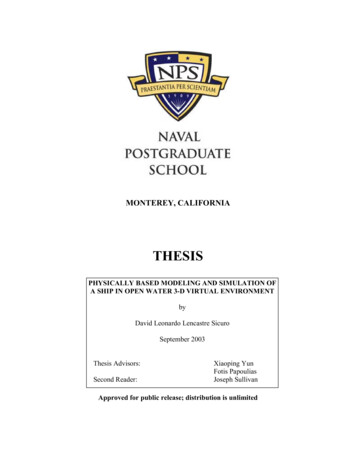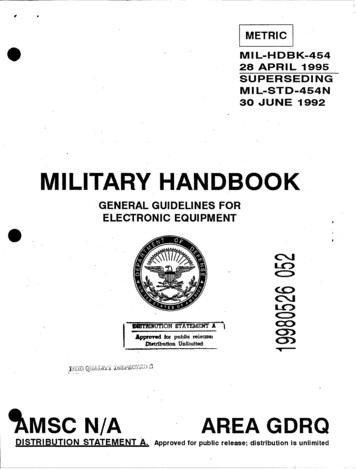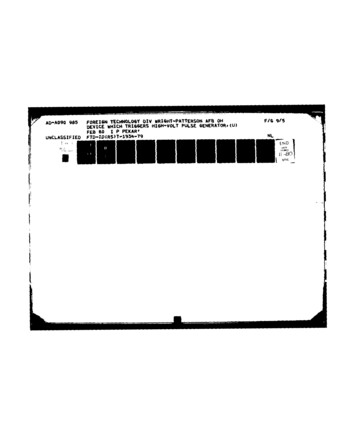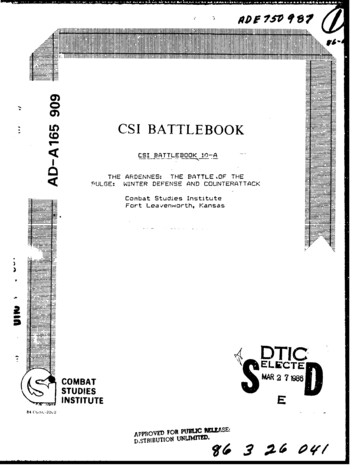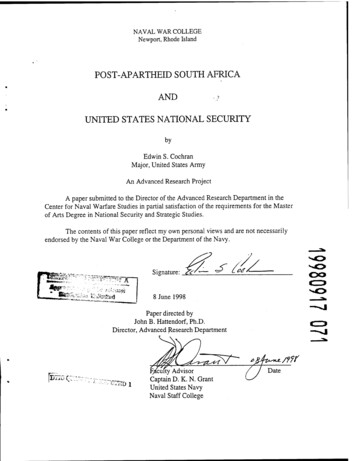
Transcription
NAVAL WAR COLLEGENewport, Rhode IslandPOST-APARTHEID SOUTH AFRICAANDUNITED STATES NATIONAL SECURITYbyEdwin S. CochranMajor, United States ArmyAn Advanced Research ProjectA paper submitted to the Director of the Advanced Research Department in theCenter for Naval Warfare Studies in partial satisfaction of the requirements for the Masterof Arts Degree in National Security and Strategic Studies.The contents of this paper reflect my own personal views and are not necessarilyendorsed by the Naval War College or the Department of the Navy.Signature:S { ftf 8 June 1998fcr-ÄJji'ä'.jPaper directed byJohn B. Hattendorf, Ph.D.Director, Advanced Research Department 7 piiC Q?äDiAdvisorCaptain D. K. N. GrantUnited States NavyNaval Staff College/?fDate
Security Classification This PageREPORT DOCUMENTATION PAGE1. Report Security Classification: UNCLASSIFIED2. Security Classification Authority:3. Declassification/Downgrading Schedule:4. Distribution/Availability of Report:DISTRIBUTION STATEMENT A: APPROVED FORPUBLIC RELEASE; DISTRIBUTION IS UNLIMITED.5. Name of Performing Organization:ADVANCED RESEARCH DEPARTMENT6. Office Symbol:7. Address: NAVAL WAR COLLEGE686 CUSHING ROADNEWPORT, RI 02841-12078. Title (include Security Classification) :POST-APARTHEID SOUTH AFRICA AND UNITED STATES NATIONAL SECURITY9. Personal Authors:EDWIN S. COCHRAN, MAJOR, U.S. ARMY10.Type of Report:12.Page Count:FINAL11. Date of Report:8 June 199E15313.Supplementary Notation:A paper submitted to the Director of the Advanced ResearchDepartment in the in Center for Naval Warfare Studies in partialsatisfaction of the requirements for the Master of Arts Degree in National Securityand Strategic Studies.The contents of this paper reflect my own personal views andare not necessarily endorsed by the NWC or the Department of the Navy.14. Ten key words that relate to your paper:regional strategy; strategic mineralsSouth Africa; Sub-Saharan Africa; United States15.Abstract: The purpose of this paper is to demonstrate the importance of continued engagement withpost-apartheid South Africa to United States national security. It is based on the realist premisethat the U.S. has limited national interests in Sub-Saharan Africa which would be best served by aregional security strategy explicitly predicated on engagement with South Africa. The paper ispresented in six chapters. Chapter One places South Africa in regional perspective as Sub-SaharanAfrica's pivotal state through an analysis of its political, economic, and military dimensions ofnational power. Chapter Two describes U.S. national interests in Sub-Saharan Africa. Theseinterests -- South Africa's transition to democracy, continued U.S. access to strategic minerals, thesecurity of U.S. economic interests, and the security of sea lines of communication -- focus on SouthAfrica and the Southern African sub-region. Chapter Three provides an analysis of the Sub-SaharanAfrican strategic environment. South Africa offers the United States the greatest opportunity formeaningful engagement in a strategic environment which is generally characterized by dysfunctionalpolitical and economic regimes and their attendant social conditions. Chapter Four describes theemergence of a U.S. policy for Sub-Saharan Africa which implicitly recognizes South Africa as theregion's pivotal state. Chapter Five is a critical analysis of U.S. regional strategy for SubSaharan Africa. This chapter demonstrates that there are significant discontinuities in U.S. policyand strategy for Sub-Saharan Africa. In effect, the U.S. lacks a comprehensive strategy for SubSaharan Africa; there are only a group of loosely coordinated political, economic, security, andinformational policy initiatives which provide the semblance, but not the substance of a regionalstrategy. Chapter Six draws conclusions concerning current U.S. policy and strategy for Sub-SaharanAfrica and presents recommendations for development of a regional strategy based on engagement withSouth Africa.16.Distribution /Availability ofAbstract:Unclassified17.Abstract Security Classification:18.Name of Responsible Individual:19.Telephone:841-2101Same As RptDTIC UsersUNCLASSIFIEDDIRECTOR, ADVANCED RESEARCH DEPARTMENT20.Office Symbol:Security Classification of This Page Unclassified
TABLE OF CONTENTSLIST OF FIGURESivLIST OF TABLESvEXECUTIVE SUMMARYviINTRODUCTION1CHAPTER 1SOUTH AFRICA: THE PIVOTAL STATE3CHAPTER 2UNITED STATES NATIONAL INTERESTSIN SUB-SAHARAN AFRICA27CHAPTER 3SUB-SAHARAN AFRICA:THE STRATEGIC ENVIRONMENT34CHAPTER 4UNITED STATES POLICY FORSUB-SAHARAN AFRICACHAPTER 5UNITED STATES POLICY FORSUB-SAHARAN AFRICA: A CRITICAL ANALYSIS.4967CHAPTER 6CONCLUSION AND RECOMMENDATIONS81FIGURES93TABLES105APPENDK A:STRATEGIC MINERALS APPLICATIONS115APPENDIX B:SUMMARY OF SUB-SAHARAN AFRICANPOLITICAL REGIMES AND ELECTION RESULTS117
TABLE OF CONTENTSNOTES123SOURCES143in
LIST OF FIGURESFIGURE 1. SUB-SAHARAN AFRICA93FIGURE 2. THE SOUTHERN AFRICAN SUB-REGION94FIGURE 3. SOUTH AFRICAN DEPARTMENT OF DEFENSEORGANIZATIONAL STRUCTURE95FIGURE 4. SOUTH AFRICAN MARITIME ZONES96FIGURE 5. SOUTH AFRICAN ARMYORGANIZATIONAL STRUCTURE97FIGURE 6. SOUTH AFRICAN AIR FORCEORGANIZATIONAL STRUCTURE98FIGURE 7. SOUTH AFRICAN NAVYORGANIZATIONAL STRUCTURE99FIGURE 8. SOUTH AFRICAN MEDICAL SERVICEORGANIZATIONAL STRUCTURE100FIGURE 9. U.S. LIFELINES AND TRANSIT REGIONS101FIGURE 10. SUB-SAHARAN AFRICAN GEOGRAPHICAL REGIONS102FIGURE 11. AFRICAN RAIL NETWORK103FIGURE 12. AFRICAN MAIN ROAD NETWORK104IV
LIST OF TABLESTABLE 1. SUB-SAHARAN AFRICAN POPULATIONSTATISTICSTABLE 2. SUB-SAHARAN AFRICAN ECONOMICSTATISTICS105108TABLE 3. SOUTH AFRICAN MINERALRESERVES AND PRODUCTION110TABLE 4. WORLD PRODUCTION ANDKNOWN RESERVES OF CHROMRJM111TABLE 5. WORLD PRODUCTION ANDKNOWN RESERVES OF COBALT112TABLE 6. WORLD PRODUCTION ANDKNOWN RESERVES OF MANGANESETABLE 7. WORLD PRODUCTION ANDKNOWN RESERVES OF PLATINUM GROUP METALS113114
EXECUTIVE SUMMARYThis paper demonstrates the importance of continued engagement with post-apartheidSouth Africa to United States national security. It concludes that there are significantdiscontinuities between United States policy and strategy for Sub-Saharan Africa, andrecommends formulation of a U.S. regional strategy predicated on engagement with SouthAfrica.During the past five years, coincident with the end of apartheid, a new United Statespolicy for Sub-Saharan Africa has emerged which implicitly recognizes South Africa's roleas the region's pivotal state. Policy, however, has not been translated into a comprehensiveregional strategy for Sub-Saharan Africa. In fact such a strategy hardly exists. United Statesengagement with Sub-Saharan Africa is executed through a collection of loosely coordinatedpolitical, economic, security, and informational policy initiatives which provide thesemblance, but not the substance of a strategy.As the result of this discontinuity between policy and strategy, executive branchagencies continue to execute programs in Sub-Saharan Africa outside of an overarchingframework and without a clear strategic objective. Most programs appear to be formulatedwith little or no regard for the political, economic, or social factors which shape the SubSaharan African strategic environment. This approach to policy implementation isinefficient, wasteful of limited resources, and distracts policymakers' attention from the fewissues in Sub-Saharan Africa which are of strategic importance to the United States. UnitedVI
States national interests would be best served through the formulation of a regional strategyexplicitly founded on engagement with South Africa.Three interacting factors support the formulation of such a strategy. These are: 1)South Africa's role as the region's pivotal state; 2) the nature of United States interests inSub-Saharan Africa; and 3) the nature of the Sub-Saharan African strategic environment.Under apartheid, South Africa's modern industrial infrastructure, highly-developedeconomy, and formidable military capabilities made it the most powerful nation in SubSaharan Africa and the dominant state in the Southern African sub-region. Analysis of itspolitical, military, and economic dimensions of national power demonstrates that since theend of apartheid in 1994 South Africa has emerged as Sub-Saharan Africa's pivotal state. Assuch, its continued stability and development are critical to peace and prosperity throughoutthe region.The United States has identifiable, but limited economic, political, and securityinterests in Sub-Saharan Africa. With the exception of overall regional stability and Nigerianoil supplies, the focus of the majority of these interests -- South Africa's transition todemocracy, continued U.S. access to strategic minerals, the security of U.S. economicinterests, and the security of sea lines of communication — is the Republic of South Africaand the Southern African sub-region.South Africa offers the United States the greatest opportunity for meaningfulengagement in a regional strategic environment which is generally characterized bydysfunctional political and economic regimes and their attendant social conditions. SouthAfrica is the only major nation in Sub-Saharan Africa currently making a transition toVll
democracy. While analysis of regional political trends does indicate some degree of politicalliberalization, the majority of Sub-Saharan African nations remain under authoritarian rule.Their appears to be no widespread regional movement toward either democratization or thedevelopment of governing structures based on the rule of law.Economically, most Sub-Saharan African nations lack a basis for sustaineddevelopment. Most of these countries are likely to remain producers and exporters or rawmaterials rather than manufacturers of exported goods. Political and economic developmentin the majority of Sub-Saharan African countries continues to be hampered by a variety ofsocial conditions which compare unfavorably with those in other developing areas. Theseinclude rampant population growth, food shortages, disease, and environmental degradation.South Africa occupies a unique position. It is at once the most powerful nation inSub-Saharan Africa and the region's pivotal state. It is also the focus of the majority ofUnited States national interests in Sub-Saharan Africa. The United States should act to endthe discontinuity in its policy and strategy for Sub-Saharan Africa through formulation of aregional strategy predicated on engagement with South Africa.via
INTRODUCTIONThe purpose of this paper is to demonstrate the importance of continued engagementwith post-apartheid South Africa to United States national security. It concludes that thereare significant discontinuities between United States policy and strategy for Sub-SaharanAfrica, and recommends formulation of a U.S. regional strategy predicated on engagementwith South Africa.South Africa occupies a unique position. The country's industrialized economy andmilitary capabilities make it the most powerful state in Sub-Saharan Africa. South Africa isalso the only major state in the region making a transition to full democracy. These factorscombine to give South Africa a significant capacity to effect regional, and to a limited extentinternational stability and mark it as Sub-Saharan Africa's pivotal state.l In addition to itsregional importance, South Africa is also the focus of the majority of United States nationalinterests in Sub-Saharan Africa.During the last five years, coincident with the end of apartheid in South Africa, a newUnited States policy for Sub-Saharan Africa has emerged. This policy implicitly recognizesSouth Africa's role as the region's pivotal state. Policy, however, has not been translated intoa comprehensive regional security strategy for Sub-Saharan Africa. In fact such a strategyhardly exists. United States engagement with Sub-Saharan Africa is executed through acollection of loosely coordinated policy initiatives which provide the semblance, but not thesubstance, of a regional strategy. The majority of these initiatives bear little relationship to
United States national interests in Sub-Saharan Africa and most of their underlying premisesare at odds with the realities of the regional strategic environment.As the result of this mismatch between United States policy and strategy for SubSaharan Africa, executive branch agencies continue to execute programs in the region outsideof an overarching framework and without a clearly defined strategic objective. This approachto policy implementation is both inefficient and wasteful of limited resources. Its focus is sodiffuse and widely scattered that it distracts policymakers' attention from the relatively fewissues in Sub-Saharan Africa that are of real strategic importance to the United States.This paper is based on the realist premise that the United States has limited nationalinterests in Sub-Saharan Africa which would be best served by a regional security strategybased on engagement with South Africa.2 Chapter One places South Africa in regionalperspective as Sub-Saharan Africa's pivotal state through an analysis of its political, military,and economic dimensions of national power. Chapter Two describes United States nationalinterests in Sub-Saharan Africa, most of which lie in South Africa and the immediateSouthern African sub-region. Chapter Three provides an analysis of the Sub-Saharan Africanstrategic environment, which offers the United States only limited opportunities for fruitfulengagement. Chapter Four describes the emergence of a United States policy for SubSaharan Africa which implicitly recognizes South Africa as the region's pivotal state.Chapter Five provides a critical analysis of United States policy initiatives for Sub-SaharanAfrica. Finally, Chapter Six draws conclusions concerning current United States policy andstrategy for Sub-Saharan Africa and presents recommendations for development of a regionalstrategy based on engagement with South Africa.
CHAPTER 1SOUTH AFRICA: THE PIVOTAL STATEOn 10 May 1994 Nelson Mandela was inaugurated as President of the Republic ofSouth Africa. This event marked the climax of one of the most emotionally laden andpotentially most important political transitions of modern times.3 Mandela's election was ofmuch more than symbolic importance. For his countrymen, the majority of whom werevoting for the first time, it signified the end of 46 years of rule by South Africa's apartheidgovernment. Instituted by the South African Nationalist Party in 1948 apartheid (literally"separateness") sought the "separate development" of South Africa's races. Apartheidprovided the policy framework for the legal, political, and social segregation of SouthAfrican whites, blacks, Indians, and "Coloreds" (people of mixed race), and the maintenanceof white minority rule.4 For many Africans, Mandela's election and South Africa's transitionto majority rule also symbolized the removal of the last vestige of European colonialism fromthe continent.5At the time of Mandela's election South Africa's modern industrial infrastructure,highly developed economy, and formidable military capabilities made it the most powerfulnation in Sub-Saharan Africa and the dominant state in the Southern African sub-region.(Sub-Saharan Africa and the Southern African sub-region are depicted at Figures 1 and 2,respectively.) Its racial policies, however, had left it effectively isolated from the rest of theinternational community. The advent of majority rule in South Africa has ended thisprevious isolation. South Africa has rejoined the community of nations; its new government
aspires to both a position of regional political leadership and one of influence in internationalorganizations. The end of apartheid has also provided the impetus for even greater SouthAfrican participation in the Sub-Saharan African economy. South Africa has, in effect,emerged as Sub-Saharan Africa's pivotal state. A pivotal state is one which.is so important regionally that its collapse would spell transboundary mayhem:migration, communal violence, pollution, disease, and so on. A pivotal state's steadyeconomic progress and stability, on the other hand, would bolster the region'seconomic vitality and political soundness and benefit American trade andinvestment.6During the past five years a United States policy for Sub-Saharan Africa has emergedwhich implicitly recognizes South Africa's pivotal role in the region. This chapter sets thestage for further discussion and analysis of U.S. policy and strategy for Sub-Saharan Africaby placing South Africa in regional context through an analysis of its political, military, andeconomic dimensions of national power.7The Political DimensionOf Sub-Saharan Africa's three most potentially powerful states, to include Nigeriaand the Democratic Republic of the Congo (DRC, formerly Zaire), South Africa is the onlyone making a transition to democracy.8 The election which brought Nelson Mandela to poweralso created a South African Government of National Unity with Mandela's African NationalCongress (ANC) as its major party. This new government has both pursued an ambitiousprogram of domestic political and economic reform, and has sought to implement a newforeign policy for South Africa.
DOMESTIC POLITICAL CONDITIONSSince the end of apartheid South Africa has made significant progress towardovercoming the legacy of a fragile, racially-based political system in which less than 20percent of its population was accorded full political and economic rights. Despite the initialmisgivings of both outside observers and South Africans themselves, the country's transitionto majority rule has been unexpectedly smooth overall.9Fundamental political change has taken place in South Africa. In 1996 the SouthAfrican government promulgated a new constitution which explicitly replaced the apartheidera governing concept of "parliamentary sovereignty" with that of the rule of law based onconstitutional supremacy. The preamble to the new constitution, which took effect on 4February 1997, defines its objectives as:[to] heal the divisions of the past and establish a society based on democratic values,social justice and fundamental human rights; lay the foundations for a democratic andopen society in which government is based on the will of the people and every citizenis equally protected by law; improve the quality of life of all citizens and free thepotential of each person; [and] build a united and democratic South Africa able totake its rightful place as a sovereign state in the family of nations.10The new constitution provided the basis for the establishment of new, Western-styleexecutive, legislative, and judicial governing authorities and formally organized the countryinto nine separate provinces, each with its own premier, legislature, and governmentservices.11 It also formally reincorporated the so-called "homelands" into the Republic ofSouth Africa.12For the majority of South Africans the ANC earned its most powerful claim topolitical legitimacy through its role in the long struggle against apartheid. The ANC nowfaces the challenge of transforming itself from a liberation movement to an effective
governing party. In the words of one former ANC guerrilla, "People can't eat democracy.We desperately need food, hospitals, houses, jobs, land, education, electricity, and water.",3Apartheid created a society characterized by one of the most inequitable distributionsof income in the world. South Africa has a population of 42.3 million, the fourth largest inSub-Saharan Africa. (Regional population statistics are at Table 1). While the overwhelmingmajority of the country's population (75.2 percent) is black, whites form a significantminority (13.6 percent).14 Most of the white one-seventh of South Africa's population enjoyincomes, material comforts, and health and educational standards equal to those of WesternEurope. In contrast, most of South Africa's remaining population endures living conditionscomparable to those of the Third World.,5South Africa's overall annual population growthrate (1.51 percent) is heavily skewed toward the poorest segment of its society. The estimatedannual rate of growth for the nation's largely impoverished black population is estimated at2.8 percent. South Africa's more affluent white population, on the other hand, is estimated tobe declining by -0.9 percent each year.16 Demographic trends tend to indicate that, withoutremediation, a progressively growing number of people at the lower end of the economicscale will be in competition for proportionally reduced amounts of wealth.In order to ameliorate these conditions the Government of National Unity hasformulated an aggressive Reconstruction and Development Program (RDP). Initiated as afive-year program in 1995, full implementation of the RDP is estimated to cost at least 37.5billion.Program objectives include poverty reduction and stimulation of economic growth,human resource development, further democratization of the South African state and society,and a broad range of urban and rural development initiatives.18
There are at least two potential unintended consequences associated withimplementation of the RDP. First, efforts to establish a more equitable distribution of wealthand social services within South African society may create expectations which theGovernment of National Unity is unable to fulfill. Second, and perhaps even morethreatening to South Africa's successful transition to democracy, would be the widespreaddevelopment of a culture of entitlement and dependency.In addition to the residual economic and social effects of apartheid, the overallstability of South African society is potentially threatened by high levels of crime. Theviolence and pressures of the anti-apartheid struggle in the black townships produced almostan entire generation of young people who lack both basic education and job skills. Infrustration, many have turned to crime as a means of support. More recently, former guerrillafighters demobilized from the military wings of the ANC and other anti-apartheid groups, aswell as former special forces personnel of the apartheid-era South African armed forces, havebeen implicated in the activities of well-organized and extremely violent criminal groups.19The challenge to internal security is so great in some areas that the government has beenforced to augment the South African Police Service (SAPS) with military forces incontinuation of a practice which began under apartheid.Problems associated with curtailing the potential effects of crime on South Africansociety are exacerbated by the low-esteem in which the nation's police services been held.20Recent public opinion surveys indicate little confidence in them at the local level; publicperceptions that the police themselves are becoming increasingly corrupt have also reducedtheir effectiveness.21 This may reflect that under apartheid SAPS had developed into a
paramilitary force whose primary focus was perceived to be the maintenance of public orderrather than the provision of traditional police services to the community as a whole. As such,SAPS was generally considered to be a highly politicized organization fully supportive of theapartheid regime. The Government of National Unity has made significant efforts to bothdemilitarize and depoliticize SAPS and to provide effective civilian oversight of itsactivities.22 Reports indicate, however, that SAPS continues to experience low morale,indiscipline, and internal divisions along racial lines.23South Africa's transition to democracy is thus far from complete, and the country islikely to experience the lingering economic and social effects of apartheid for severalgenerations. South Africa's next national elections are scheduled for April 1999. Given theANC's near-dominance of the Government of National Unity and widespread perceptions ofits legitimacy, as well as the absence of viable opposition political parties at the nationallevel, it is expected that ANC Executive Deputy President Thabo Mbeki will succeedMandela as President. The real test of South Africa's transition to democracy will comewhen Mbeki stands for reelection in 2004. By then the ANC is likely to fragment to someextent and new opposition parties will probably emerge to challenge its politicaldominance.The ANC's ability to effectively govern in the presence of opposition, or evento peacefully transfer power in the event of an election defeat, will be critical indicators of thesuccess of South Africa's transition to democracy.25
FOREIGN POLICYShortly before his election to the South African presidency Nelson Mandela wrote,"The African National Congress believes that the charting of a new foreign policy for SouthAfrica is a key element in the creation of a peaceful and prosperous country."26 TheGovernment of National Unity's foreign policy appears radically different from that of itsapartheid-era predecessor. Most of its underlying tenets are far removed from realist notionsof international relations. South Africa's declared foreign policy principals emphasizesupport for human rights, internationalism, a commitment to promoting regional growth and*cooperation, and adherence to international arms control conventions.97President Mandela conceives the fundamental goal of the post-Cold War internationalsystem as the creation of universal democracy, peace, and prosperity.28 He has repeatedlyemphasized the centrality of these concepts to South Africa's new foreign policy, which alsoincludes a strong commitment to human rights. ("Human rights will be the light that guidesour foreign policy." 29) Commenting on apartheid's corrosive social and economic effects onSouth Africa, President Mandela has also declared that "a central goal" of South Africa'sforeign policy is the promotion "of institutions and forces that, through democratic means,seek to make the world safe for diversity."30The basis of South Africa's foreign policy is strongly internationalist. "Peace is thegoal for which all nations should strive," wrote Mandela," and when this breaks down,internationally agreed and non-violent mechanisms.must be employed" for its restoration.In a speech to the United States Congress on 6 October 1994 President Mandela stated:.in an age such as this.much revision will have to be done of ideas that have seemedas stable as the rocks, including such concepts as sovereignty and national interest.
What we speak of is the evolution of the objective world, which inexorably says to allof us that we are human together or nothing at all.32Equating global interdependence with international responsibility, he continued:.the world is one stage and the actions of its inhabitants part of the samedrama.[therefore] each one of us as nations.should begin to define the nationalinterest to include the genuine happiness of others, however distant in time and spacetheir domicile might be.33Consistent with these principals, the Government of National Unity moved quickly toend South Africa's international political isolation. In May 1994 the country became amember of both the Organization of African Unity and the Non-Aligned Movement. Thefollowing month South Africa rejoined the Commonwealth (after an absence of 33 years) andreclaimed its seat in the United Nations, from which the country had withdrawn two decadesearlier. South Africa also became a signatory to the Universal Declaration of Human Rightsin October 1994. Within the United Nations, South Africa has been a leading proponent ofrestructuring the Security Council in order to afford greater representation to lesser developedcountries.As part of its new foreign policy, South Africa also seeks to fulfill its "Africandestiny" by playing a leading role in the economic development and integration of theSouthern African sub-region. It views the ultimate objectives of its own Reconstruction andDevelopment Program as an integral part of this process. "Southern Africa commands aspecial priority in our foreign policy. We are inextricably part of Southern Africa and ourdestiny is linked to that of a region which is much more than a mere geographical concept." 34South Africa's new political leaders are bound to their neighbors by self-interest aswell as a sense of obligation for the support that many of these countries lent to the ANC and10
other groups during their struggle against apartheid.35 The Government of National Unity hasarticulated its overarching vision for the Southern African sub-region as. .the highest possible degree of economic co-operation, mutual assistance wherenecessary and joint planning consistent with socio-economic, environmental andpolitical realities. South Africa seeks to achieve regional economic developmentthrough the [Southern African Development Community]36South Africa acceded to the Southern African Development Community (SADC)Treaty on 29 August 1994.37 President Mandela became Chairperson of the SADC in on 24August 1996, and South Africa will chair the organization until 31 August 1999. During thatperiod, South Africa is "expected to provide political guidance and leadership to theregion."38 The Government of National Unity , and President Mandela personally, are alsoproponents of the development of indigenous regional conflict resolution and peacekeepingmechanisms. South Africa has played an active role in conflict resolution in the DRC andSudan, and South African armed forces have participated in at least one exercise intended aspreparation for "peacekeeping tasks on the continent."39Finally, South Africa's foreign policy includes a declared commitment to theinternational non-proliferation regime. South Africa actually acceded to the Nuclear NonProliferation Treaty (NPT) under its apartheid government on 10 July 1991. South Africa isunique in that it is the only country to have
post-apartheid south africa and united states national security 9. personal authors: edwin s. cochran, major, . executive summary vi introduction 1 chapter 1 south africa: the pivotal state 3 chapter 2 . south african medical service organizational structure 100 figure 9. u.s. lifelines and transit regions 101
